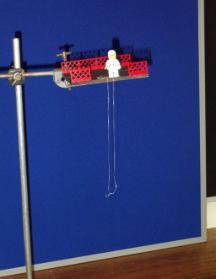Higher, Faster, Stronger (HFS)
Most people have engaged in sports of some kind, but they will rarely have analysed their performance in any detail. This chapter, through software analysis of video clips allows students to (i) measure speeds and accelerations in sprinting and jogging, (ii) measure work and power in weight-lifting, (iii) look at forces and vector quantities in rock climbing, (vi) analyse forces and moments in gymnastics (v) analyse forces and projectiles in tennis and (vi) analyse forces and energy transfers in bungee jumping.
The photograph shows one of the SHAP authors taking a bungee jump in New Zealand. One of the course activities is to predict, with the aid of some data on the model rope and person, the optimum dropping height for a model bungee jumper.
The chapter provides an interesting means of looking at Newtonian dynamics without having to don a tracksuit. It also shows how physics contributes to sports science in trying to improve the achievements of athletes.

The main physics content areas are:
- Graphs, equations of motion
- Projectiles
- Force, mass, momentum and acceleration
- Centre of mass and principle of moments
- Kinetic and potential energy
